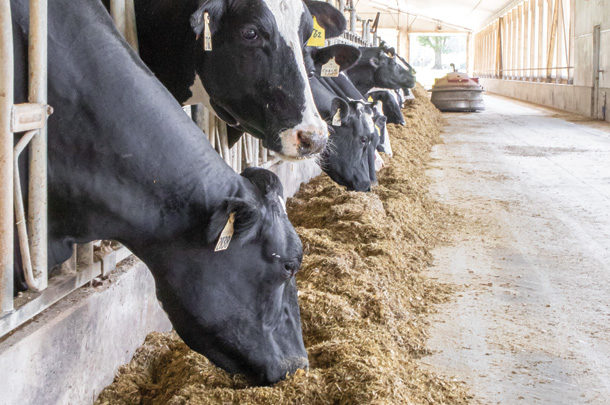The consequences of feed sorting on cow health and production have been well documented within the industry. Cows often sort in favour of smaller grain components, as these are typically the most palatable, and sort against the longer, bulkier forage components.
We know when cows sort their feed, not only are they at risk of consuming an imbalanced diet, but they are also compromising the quality of feed for cows visiting the bunk later in the day. We also know sorting behaviour can negatively impact rumen health and increase the risk of ruminal acidosis. When these smaller grain components are rapidly fermented in the rumen, they abruptly lower rumen pH to potentially acidic levels.
Additionally, some research has sought to explain the motivations behind feed sorting. Studies from the University of Guelph show cows will change how they sort, depending on their metabolic state. For example, a study from 2020 found cows in a state of negative energy balance (NEB) increased their sorting behaviour in favour of the smaller, more energy-dense components of the diet, whereas cows facing a more severe degree of NEB sorted to a higher extent in favour of these higher-energy components compared to cows facing a lower severity of NEB.
Similarly, an earlier study from 2017 found cows will do the opposite when experiencing, or when at risk for, subacute ruminal acidosis (SARA). In this case, cows will increase their sorting in favour of the longer, more fibre-dense portions of the diet, as these components stimulate rumination and chewing to act as a buffer within the rumen. This is likely to attenuate the negative effects they may be experiencing. Regardless of the motivation behind sorting, both cases have the ability to impact cow health and production. There is an abundance of research and knowledge on how feed sorting impacts cow health, welfare and production, but limited work has focused on the economic impact of feed sorting.
Economic consequences on feeding costs and nutrition
Feed costs are the highest expense on dairy farms, so ensuring the total mixed ration (TMR) is being consumed correctly, and feed waste is limited, is very important. When cows sort their feed, they are altering the nutrient composition of their diet. Unless frequent feedbunk analysis is performed using the Penn State Particle Separator (PSPS), the degree and severity of sorting may go unnoticed. More commonly, producers may notice an increase in feed refusals, specifically containing long forage particles like corn husks and pieces of long straw or hay.
Research has demonstrated the more time cows spend sorting, the less time they spend physically eating the diet, resulting in lower dry matter intake (DMI). Furthermore, the subordinate cows visiting the bunk later in the day may not be able to eat the well-balanced, nutritious diet formulated for them if other cows have already picked through it. These subordinate cows will now be at risk of consuming a diet with lower nutrient and energy density. Many studies have shown DMI will decrease when greater amounts of forage and fibre are present in a diet, due to the time it takes for mastication of these forages, the physical constraints and the potential impact of gut fill. Thus, these subordinate cows may also have decreased DMI because of the feed sorting that occurred earlier in the day. This decrease in DMI will influence both feed and milk efficiency, ultimately costing the producer economically in the long run.
Economic impact on milk production and health
Many researchers over the past decades have focused on improving feed efficiency while encouraging high milk yield and components. It is well documented that feed sorting can directly impact DMI, milk yield and milk components. Specifically, we know increased concentrate intake can result in a depression of milkfat yield and percentage due to the increased risk of SARA and impact on the rumen environment. Knowing Canadian producers are paid based on the volume of solid components in milk (through fat, protein, lactose and other solids), any factor impacting milk component production may result in economic losses for the producer.
Research on feed sorting done by a lab group led by Dr. Trevor DeVries at the University of Guelph, investigated how sorting (measured by analyzing particle distribution at feed delivery and comparing it to particle distribution 24 hours later) influenced milk production and efficiency. This research demonstrated efficiency of milk production (milk yield/average DMI) decreased by roughly 3% for every 1% increase in pen or group fine fraction (typically where small grains are) overconsumption. Additionally, for every 2% increase in group-level sorting against long forage fraction in the diet, milk yield decreased by 1 kilogram per day.
To put this in perspective, consider a hypothetical dairy farm, milking 100 cows, with an average milk production of 26 kilograms per day. Imagine the feed was analyzed at feeding (hour zero) and then again right before refusals were picked up the next day (hour 24). The hypothetical, but realistic, PSPS results for this farm are shown in Table 1.

Based on the above research, this would result in a potential 15% decrease in herd milk production efficiency and a potential 7 kilograms per day decrease in herd-level milk production. Additionally, this research group concluded a reduction in group-level sorting against the long particles (top screen) was associated with greater milkfat yield and, as a result, an opportunity for producers to make more money. When cows reduce sorting against this fraction, they increase their fibre intake and thereby increase rumen pH and promote more favourable conditions for milkfat synthesis.
On the other hand, when cows consume higher quantities of rapidly fermentable carbohydrates or grains relative to fibre, they have an increased risk of experiencing SARA. This is defined as a prolonged drop in rumen pH, below a threshold of 5.6. When this happens, the rumen can become acidic and the cow may experience a decrease in DMI, milk yield and milkfat percentage.
The incidence of SARA in the dairy industry is reported to be 19% to 26%. If we use the median of 22% and the hypothetical farm example, 22 cows from this herd would experience SARA. Research from Cornell University in 1999 concluded SARA reduced milk yield by 2.7 kilograms per day. Similarly, milk protein yield dropped by 0.12% and milkfat by 0.3%, for an estimated total cost of $500 per case per cow per year. Using the estimate of 22 cows, this could cost the farm approximately $11,500, without accounting for inflation, the cost of culling or veterinary treatment.
How do we reduce feed sorting and the associated economic impact?
Unfortunately, there is no simple answer, as many factors play a role in feed sorting. For example, moisture content, particle size, palatability, stage of lactation, metabolic status and social stressors are all factors that influence feed sorting.
While cow level factors are a bit harder to control, we can limit sorting through proper feeding management. Longer forage particle size encourages increased sorting behaviour, so limiting particle size to the recommended 1 inch can encourage consumption of a homogenous diet. Furthermore, allowing forages to stay in the mixer wagon longer and keeping blades sharp and well maintained will help. Additional strategies include adding water or liquid feeds and sugars to TMR; this creates a “stickier” texture and limits the physical ability of cows to sort. Research from the University of Alberta and the University of Guelph found feeding liquid sugars helped encourage DMI, increase milk production and reduce feed sorting behaviours.
Lastly, management strategies such as adequate head space at the bunk, limiting overstocking, frequent feed push-ups and multiple daily feedings of fresh feed are all proven techniques to help reduce feed sorting on-farm.
Making these small changes and management decisions now may just save you later, from both a cow health and performance perspective, but also an economic one. Dairy producers spend anywhere from hundreds of thousands to millions of dollars each year to feed their animals highly formulated diets and ensure high production levels. Understanding the cost of ration sorting, both economically and on cow health, is the first step in motivating changes to reduce these behaviours and maximize the future success of your herd.
Sydney Moore is a Ph.D. student at the University of British Columbia. Casey Havekes, M.Sc., is a dairy management specialist with Cornell Cooperative Extension. They provided the article on behalf of Liquid Feeds Inc.









